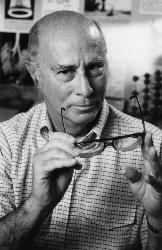Robert L. Fleischer, research professor of geology and a retired GE scientist with experience in NASA’s Apollo program, died March 3, 2011, after a long illness. He was 80.
Born in Columbus, Ohio, he attended Harvard University, where he earned a Ph.D. After a position as professor of metallurgy at MIT, he moved to Schenectady and spent most of his 32-year research career as a scientist at the GE Global Research Center in Niskayuna. Fleischer joined the College in 1997 after he retired from GE.
His early work at GE was on hardening of solids, and later work was on nuclear tracks in solids. This latter field brought with it extensive collaborations in multiple disciplines. He and his colleagues designed the cosmic ray detector taken to the moon and back by the Apollo 16 astronauts, studied the damaging effects of cosmic rays on moon rocks, and dated meteorites and archeological specimens.
Much of his research at Union was in the area of radioactivity in the environment. He used damage tracks made by charged particles in glass and other materials to determine levels of exposure. He used glass from the 1945 Hiroshima bomb site to determine neutron dosimetry. He received national media attention in 2000 for a project in which he used fission tracks in eyeglass lenses to determine personal exposure to radon.
He published over 350 scientific papers and held 19 patents. His fission track work led to two companies founded by GE -- Nuclepore, which produced thin membranes with holes of cleanly specified sizes; and Terradex, which produced radon measuring for home safety or for locating shallow deposits of uranium in the ground.
He was instrumental in arranging visits to Union by two astronauts who were former NASA colleagues: Bonnie Dunbar, who flew five times aboard the Space Shuttle; and Harrison Schmitt, the Apollo 17 astronaut who was the last person to walk on the moon.
His awards include the American Nuclear Society’s Special Award for Distinguished Service in the Advancement of Nuclear Science in 1964, the U.S. Atomic Energy commission's E.O. Lawrence Award in 1971, and NASA’s Medal for Exceptional Scientific Achievement in 1973. He was presented with GE’s Coolidge Fellowship Award in 1972 for sustained technical contributions, and was elected to the National Academy of Engineering and the American Academy of Arts and Sciences.
He co-authored "Nuclear Tracks in Solids," wrote "Tracks to Innovation," and co-edited book sets on intermetallic compounds.
Survivors include his wife of 56 years, Barbara; and two daughters, Cathy and Elizabeth.
A memorial service will be Sunday, March 13, at 1 p.m. at Congregation Gates of Heaven, 852 Ashmore Ave., Schenectady, N.Y. 12309, followed by calling hours at the family home at 1356 Waverly Place, Schenectady.
Memorial contributions may be made to the American Heart Association’s Northeastern New York Chapter, 440 New Karner Rd., Albany, N.Y. 12205; Congregation Gates of Heaven; the Amyloid Treatment and Research Program, Boston University School of Medicine, 72 East Concord Street, K-503, Boston, Mass. 02118; or a charity of your choice.
